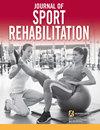在有前十字韧带重建史的人群中,与受伤有关的恐惧与等速股四头肌力量之间没有关联。
IF 1.3
4区 医学
Q3 REHABILITATION
引用次数: 0
摘要
前交叉韧带(ACL)二次损伤风险与损伤相关恐惧和股四头肌力量独立相关。尽管与受伤有关的恐惧和股四头肌力量对继发性前交叉韧带损伤有各自的预测能力,但它们之间是否存在关联尚不清楚。本研究的目的是研究前交叉韧带重建(ACLR)术后至少 1 年的人的受伤相关恐惧与股四头肌力量之间的关联。参与者完成了坦帕运动恐惧量表-11(TSK-11)和使用 Biodex 等动测力计进行的标准等动股四头肌力量评估。我们使用皮尔逊乘积-矩相关性来检验 TSK-11 评分与每个肢体的峰值扭矩(单位:纳米/公斤)之间的线性关系,以及 TSK-11 评分与每个肢体的肢体对称性指数之间的线性关系。Pearson Product-Moment 相关系数 (r) 被解释为非常高(.90-1.00)、高(.70-.90)、中等(.50-.70)、低(.30-.50)和无相关性(.00-.30)。结果:TSK-11 平均得分为 18.2 (5.3),ACLR 股四头肌峰值扭矩平均为 1.9 (0.50) N-m/kg,对侧股四头肌峰值扭矩平均为 2.3 (0.48) N-m/kg,肢体对称指数平均为 85.3% (12.6%)。TSK-11与前交叉韧带重建肢体的股四头肌峰值扭矩(r = .12,P = .46)、TSK-11与对侧肢体(r = .29,P = .07)或TSK-11与肢体对称性指数(r = -.18,P = .27)之间均无统计学意义上的相关性。事实证明,这两个因素会单独影响 ACLR 术后患者二次损伤的风险。本文章由计算机程序翻译,如有差异,请以英文原文为准。
No Association Between Injury-Related Fear and Isokinetic Quadriceps Strength in Individuals With a History of Anterior Cruciate Ligament Reconstruction.
CONTEXT
Injury-related fear and quadriceps strength are independently associated with secondary anterior cruciate ligament (ACL) injury risk. It is not known whether injury-related fear and quadriceps strength are associated, despite their individual predictive capabilities of secondary ACL injury. The purpose of this study was to examine the association between injury-related fear and quadriceps strength in individuals at least 1 year after ACL reconstruction (ACLR).
DESIGN
Cross-sectional study.
METHODS
Forty participants between the ages of 18 and 35 years at least 1 year post unilateral primary ACLR. Participants completed the Tampa Scale of Kinesiophobia-11 (TSK-11) and a standard isokinetic quadriceps strength assessment using the Biodex Isokinetic Dynamometer. Pearson Product-Moment correlations were used to examine the linear association between the TSK-11 scores and peak torque (in nanometers per kilogram) for each limb and between the TSK-11 scores and limb symmetry indices for each limb. Pearson Product-Moment correlation coefficients (r) were interpreted as very high (.90-1.00), high (.70-.90), moderate (.50-.70), low (.30-.50), and no correlation (.00-.30).
RESULTS
The average TSK-11 score was 18.2 (5.3), average ACLR peak quadriceps torque was 1.9 (0.50) N·m/kg, average contralateral peak quadriceps torque was 2.3 (0.48) N·m/kg, and average limb symmetry index was 85.3% (12.6%). There was no statistically significant correlation between the TSK-11 and peak quadriceps torque on the ACLR limb (r = .12, P = .46), the TSK-11 and contralateral limb (r = .29, P = .07), or the TSK-11 and limb symmetry index (r = -.18, P = .27).
CONCLUSIONS
There was no association between kinesiophobia and peak isokinetic quadriceps strength in individuals at least 1 year post-ACLR. Both factors, independently, have been shown to influence risk of secondary injury in patients after ACLR.
求助全文
通过发布文献求助,成功后即可免费获取论文全文。
去求助
来源期刊

Journal of Sport Rehabilitation
医学-康复医学
CiteScore
3.20
自引率
5.90%
发文量
143
审稿时长
>12 weeks
期刊介绍:
The Journal of Sport Rehabilitation (JSR) is your source for the latest peer-reviewed research in the field of sport rehabilitation. All members of the sports-medicine team will benefit from the wealth of important information in each issue. JSR is completely devoted to the rehabilitation of sport and exercise injuries, regardless of the age, gender, sport ability, level of fitness, or health status of the participant.
JSR publishes peer-reviewed original research, systematic reviews/meta-analyses, critically appraised topics (CATs), case studies/series, and technical reports that directly affect the management and rehabilitation of injuries incurred during sport-related activities, irrespective of the individual’s age, gender, sport ability, level of fitness, or health status. The journal is intended to provide an international, multidisciplinary forum to serve the needs of all members of the sports medicine team, including athletic trainers/therapists, sport physical therapists/physiotherapists, sports medicine physicians, and other health care and medical professionals.
 求助内容:
求助内容: 应助结果提醒方式:
应助结果提醒方式:


